Zounds, a dog, a rat, a mouse, a cat, to scratch a man to death!
a braggart, a rogue, a villain, that fights by the book of arithmetic!
[Shakespeare: Romeo and Juliet - III, i]
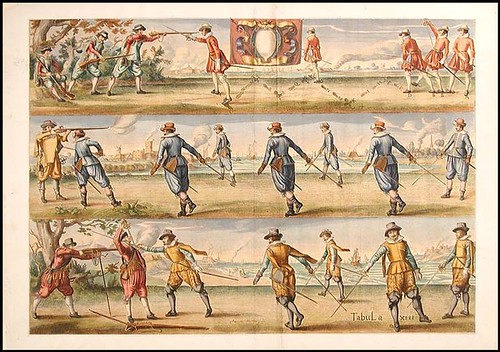
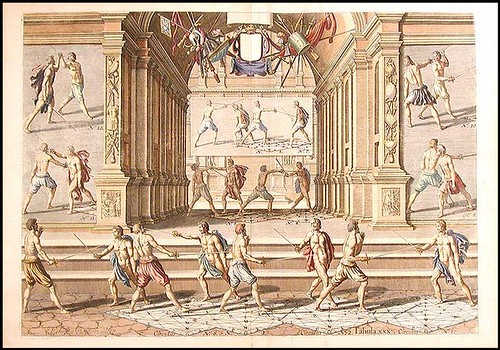

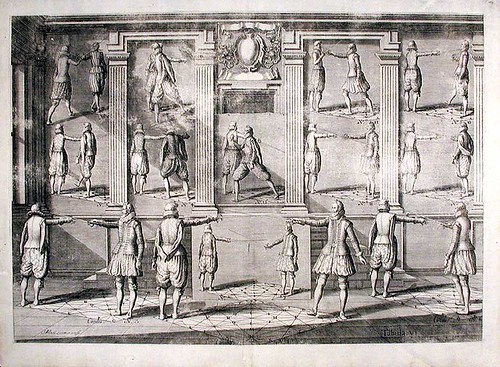
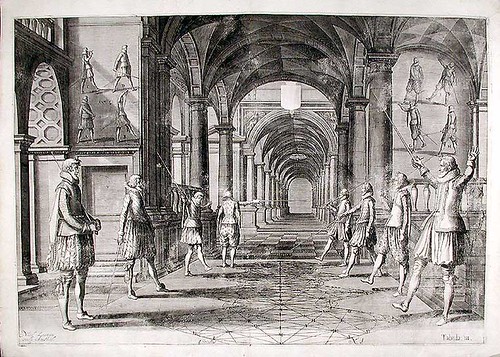



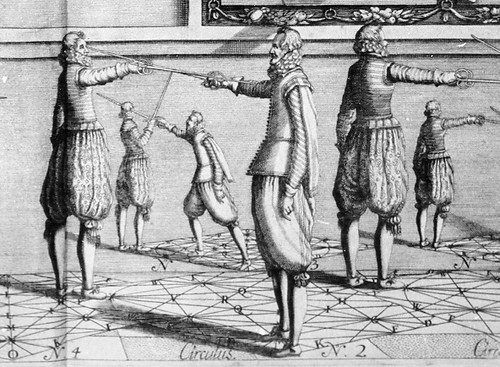
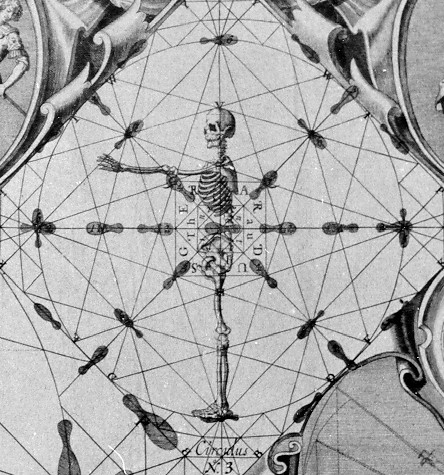
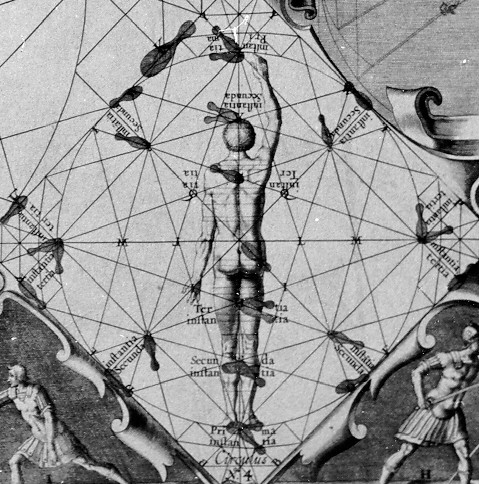
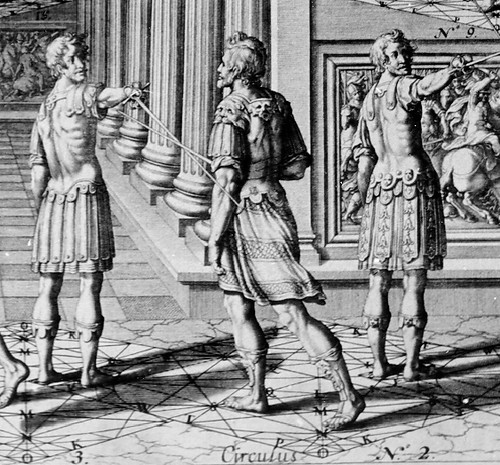
Between the 16th and 18th centuries swordplay experienced an evolution in technology and technique. The heavier broadswords which were often just used as bludgeoning weapons began to give way to lighter and narrower breeds, particularly the rapier, whose sharp point was better able to pierce a combatant and whose extra length allowed for both a greater reach and better defensive positioning.
These new weapons also became fashionable sidearms for use in civilian combat, duels and for purely sporting purposes. The cumbersome tactics employed with the older weapons, which relied on brute strength brought to bear on the cutting edge of the blades, were superseded by more dexterous skills and speed, where the tip of the sword and the lunge were emphasised. Fencing techniques came to be regarded as more of a science during the 16th century and were naturally influenced by the advancements that occurred during the Renaissance.
The Spanish school of swordsmanship - 'La Destreza' ('high level skill') - emerged as the leading theoretical system in Europe in the 1550s with a book published by Geronimo Carranza in which geometry became a primary source for insight into combat techniques. His pupil, Luis Pacheco de Navarez, expanded the theory in his own work published at the end of the century.
Navarez was to train a Flemish swordsman (and doctor, poet, artist, architect and occultist), Girard Thibault (Thibault d'Anvers), who became a Master in the Spanish fencing methods in the first decade of the 17th century. His accumulated knowledge, together with the advancements to the mathematical theories he made himself, were collected and published in 1630 (although the book bears a 1628 date) in the most elaborate and lavishly illustrated fencing treatise ever produced. Thibault first acquired royal patents for his work in about 1620 so it essentially took him ten years to finally get his volume released, and it included more than forty sumptuous double-page folio engravings by some sixteen of the best artists of the day (eg. Crispin de Passe, Pieter Serwouters, Schelte and Boetius Bolswert, Saloman Savery, Jakob Goltzius, Peter Isselburg, Pieter de Jode &c).
A central tenet of the Thibault thesis on Spanish swordsmanship is the idea of a magic or mysterious (as it was to contemporary observers) or Thibault circle - essentially the diameter of an imaginary ring on the ground in which the stance, attack and defensive positioning all take place. The size of this circle corresponds to the height of the swordsman to the tip of his outstrectched finger (seen in a couple of the above images). All of the tactical movements are described by circular and linear concepts and a knowledge of geometry is fundamental to exploiting the strongest positions.
"The dogmatic Thibault d’Anvers, who only admits perfectly defined calculations in his theories, speaks, however, of the feeling of the sword, the feeling of iron, referring to the very current proprioceptive and kinaesthetic qualities, rather than to improvisation and adaptability. His theories are based on mechanical reflexes and stereotypes with a strictness, completely geometric, inscribed in a mysterious circle which, according to him, is the basis of the science of fencing."Thibault's text was "founded squarely on the on traditions of spiritual philosophy and practice and formed one of several practical expressions of Renaissance Hermetic occultism". Mystical pythagorean geometry is said to have found its place during the Renaissance in the esoteric arts of occultism. In that light, it's perhaps unsurprising that Thibault quotes at length from 'De Occulta Philosophia Libri Tres' by German magician HC Agrippa. All this is just to say that, rather than being a secret discipline based on the wearing of puffy trousers, Destreza may well be the only esoteric western martial art.
The full title in english of 'Academie de l'Espee' is:
'Academy of the Sword. Wherein is demonstrated by mathematical rules on the foundation of a mysterious circle, the theory and practice of the true and heretofore unknown secrets of handling arms on foot and horseback'. But the horseback section was never completed - Thibault died prior to release of the book.
- So rare is the original of this work that it only appears on the market once or twice a decade and one notice I found lists its price at over $50,000. If that's likely to cut into your rent money, there was a re-release in english last year (some page views). RvR Verlag also have a more extravagant version.
- The complete 'Academie de l'Espee' does not appear to be online. The images above (mouseover for site) were extracted from: Met Museum; 'Fiore dei Liberi' gallery; Donald Heald Gallery (frontispieces); JFGillies (flash) gallery. [see also some small colour versions at Glazer Gallery] {the images towards the end with black borders were spliced from screencaps}
- 'Renaissance Martial Arts Literature' (general overview) at ARMA
- 'From Duelling to Fencing' at Fencing Online.
- 'The Demystification of the Spanish School' by Maestro Ramón Martínez (in three parts).
- 'The Spanish Circle' by HL John James MacCrimmon.
- Previously: combat.
- Addit --- see also: Destreza Translation and Research Project [Thanks D.Biggs]



















7 comments :
The Shakespeare quote certainly gives the (rather decorous) fight images that certain je ne sais quoi. And the info on the occult aspect of sword-fighting is most intriguing.
The complexities of La Destreza were apparently spoofed in a 1627 work by one Antonio Francesco Lucini entitled Compendia dell'armi de Caramogi. I've found a couple of samples of this book's illustrations here & there, & have for quite a while been hoping to find a wider selection of them: if in your travels you ever happen to find any, please do let me know…
Excellent! Thanks for posting these images!
One note and one criticism:
You might want to also look here (http://www.plumes.org/destreza/) for information on the Spanish Destreza.
In general, the renaissance rapiers weighed as much as the earlier single-handed swords. They were merely balanced differently. Also, the earlier fencing was every bit as technical and nuanced as the renaissance and later styles. It wasn't just about brute strength and hacking.
For more on the subject see:
Chicago Swordplay Guild
AEMMA
Tattershall School of Defense
Order of the seven hearts
...and others.
D Biggs
Rector - Tattershall School of Defense
Karla, yes, I was quite spun by the degree of significance that esoterica had in the evolution of the art - I guess it's part and parcel with the melding of emerging science and philosophoalchemicalmagica or however the melting pot of knowledge of the period might be described.
misteraitch you are a tease. Before your message I had spent a(nother) fruitless hour searching for Luca Cambiaso geometric sketches [eg] a la Bracelli (from that IHT article you once posted).
I have again come up short with all permutations on Lucini's name (and that of the work mentioned) in a whole raft of sites/dbases. I remain very intrigued, but emptyhanded.
Law, thanks for your comment. I would certainly be very foolish to attempt any deflection of your criticisms given the ignorant (defensive!) position I occupy in this circle of discussion.
I can only say that I read a lot more material than the links posted (although not the excellent link you provided - thanks).
Perhaps I was clumsy with the wording and inferences, but I got the feeling that over that 1550-1700 period the weight was reduced in comparison to the broad swords - I see from this ARMA article that there is a reference to early and late rapiers so you'll allow that I was giving a 'broad' trend overview.
Again, I defer to your superior knowledge about the physical tactics of broadsword use -- perhaps I imbued those opening remarks with a little poetic license for comparison's sake (but it was suggested from my reading, not from my guesswork).
Oddly enough, I had meant to e-mail you about the Lucini book, and, at the same time, I was planning to mention having found a single geometric sketch a little like that of Cambiaso’s—a perspective drawing by Erhard Schön, apparently dating from 1543, and later reproduced by one R. Becker in 1808, and then again in Jurgis Baltrušaitis’s book Anamorphic Art.
Accidental cubism? Seems appropriate here: geometric and perspective lines are of the same family. I came across another anamorphic pic from Schön, though it's of a different nature.
Since the topic was mentioned, an anamorphic set would always be a fine thing if you happened to collect some... although I'm not sure that the computer screen is the best way to view them. It's quite fun watching museum visitors check out the anamorphic Holbein skull, for one thing. Very multi-generational entertainment.
Post a Comment
Comments are all moderated so don't waste your time spamming: they will never show up.
If you include ANY links that aren't pertinent to the blog post or discussion they will be deleted and a rash will break out in your underwear.
Also: please play the ball and not the person.
Note: only a member of this blog may post a comment.